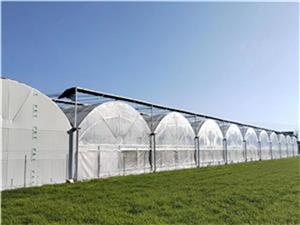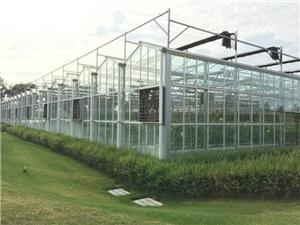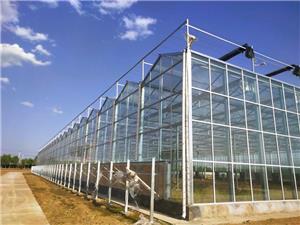Dutch vegetable greenhouse materials
Dutch vegetable greenhouses are among the most advanced agricultural technologies in the world. To create the best growing environment, the design, material selection, and installation of greenhouses all require meticulous planning and implementation. Here is more detailed information about greenhouse materials:
1. Glass material: Glass is the most widely used type of greenhouse covering material. In the Netherlands, tempered glass is typically used for glass greenhouses, with a thickness of 4-5 millimeters. It has high impact resistance and strength. Tempered glass can withstand harsh weather conditions such as wind, rain, and snow, and prevent strong light exposure. It can also increase humidity inside the greenhouse, providing a comfortable environment for plant growth. Glass material is more expensive than plastic material, but it has a lifespan of over 20 years, making it a viable option for large-scale plantations with long-term use.
2. Plastic Materials: Plastic is another widely used material for greenhouse covers. In the Netherlands, vegetable greenhouses typically use plastic films such as polyethylene or polyvinyl chloride. These materials have good light transmission, water resistance, and UV resistance. They also have the advantages of being lightweight, easy to maintain and replace, and relatively low in price. However, the strength and durability of plastic films are not as good as those of glass, and they usually need to be replaced every 3 to 5 years. Therefore, for large-scale plantations with long-term use, the cost of replacement needs to be considered.
3. Metal Materials: The vegetable greenhouses in the Netherlands typically use aluminum alloy or steel to make the support structures. Aluminum alloy is a lightweight, corrosion-resistant material with high strength and stability. It can withstand the weight and various external forces in the greenhouse support and has good durability. Steel is stronger and more durable, but heavier and requires a stronger support to bear it. Metal support structures have a long service life and are a feasible choice for large-scale plantations that are used for a long time.
Overall, the design of vegetable greenhouses in the Netherlands is very advanced. The choice of greenhouse materials depends on various factors such as budget, required light transmission, insulation, wind resistance, rain protection, pest control, and safety. There are many factors to consider, so designers will choose the best materials based on specific circumstances.
In addition, Dutch vegetable greenhouses also adopt some advanced technologies, such as:
1. Automation systems: The temperature, humidity, irrigation, and fertilization in the greenhouse are all controlled and monitored by advanced computers. This automation system can ensure that the environment in the greenhouse is always in the best condition, improving yield and quality.
2. LED lighting: To provide sufficient light in winter and at night, Dutch vegetable greenhouses use LED lighting systems. This light can provide different spectral ranges, allowing plants to obtain the required spectrum and intensity at different growth stages.
3. CO2 injection system: To promote plant growth, Dutch vegetable greenhouses use CO2 injection systems. This system can increase the CO2 concentration in the greenhouse, thereby improving the photosynthesis efficiency and growth rate of plants.
Dutch vegetable greenhouses are among the most advanced agricultural technologies in the world. To create the best growing environment, the design, material selection, and installation of greenhouses all require meticulous planning and implementation. Here is more detailed information about greenhouse materials:
1. Glass material: Glass is the most widely used type of greenhouse covering material. In the Netherlands, tempered glass is typically used for glass greenhouses, with a thickness of 4-5 millimeters. It has high impact resistance and strength. Tempered glass can withstand harsh weather conditions such as wind, rain, and snow, and prevent strong light exposure. It can also increase humidity inside the greenhouse, providing a comfortable environment for plant growth. Glass material is more expensive than plastic material, but it has a lifespan of over 20 years, making it a viable option for large-scale plantations with long-term use.
2. Plastic Materials: Plastic is another widely used material for greenhouse covers. In the Netherlands, vegetable greenhouses typically use plastic films such as polyethylene or polyvinyl chloride. These materials have good light transmission, water resistance, and UV resistance. They also have the advantages of being lightweight, easy to maintain and replace, and relatively low in price. However, the strength and durability of plastic films are not as good as those of glass, and they usually need to be replaced every 3 to 5 years. Therefore, for large-scale plantations with long-term use, the cost of replacement needs to be considered.
3. Metal Materials: The vegetable greenhouses in the Netherlands typically use aluminum alloy or steel to make the support structures. Aluminum alloy is a lightweight, corrosion-resistant material with high strength and stability. It can withstand the weight and various external forces in the greenhouse support and has good durability. Steel is stronger and more durable, but heavier and requires a stronger support to bear it. Metal support structures have a long service life and are a feasible choice for large-scale plantations that are used for a long time.
Overall, the design of vegetable greenhouses in the Netherlands is very advanced. The choice of greenhouse materials depends on various factors such as budget, required light transmission, insulation, wind resistance, rain protection, pest control, and safety. There are many factors to consider, so designers will choose the best materials based on specific circumstances.
In addition, Dutch vegetable greenhouses also adopt some advanced technologies, such as:
1. Automation systems: The temperature, humidity, irrigation, and fertilization in the greenhouse are all controlled and monitored by advanced computers. This automation system can ensure that the environment in the greenhouse is always in the best condition, improving yield and quality.
2. LED lighting: To provide sufficient light in winter and at night, Dutch vegetable greenhouses use LED lighting systems. This light can provide different spectral ranges, allowing plants to obtain the required spectrum and intensity at different growth stages.
3. CO2 injection system: To promote plant growth, Dutch vegetable greenhouses use CO2 injection systems. This system can increase the CO2 concentration in the greenhouse, thereby improving the photosynthesis efficiency and growth rate of plants.




